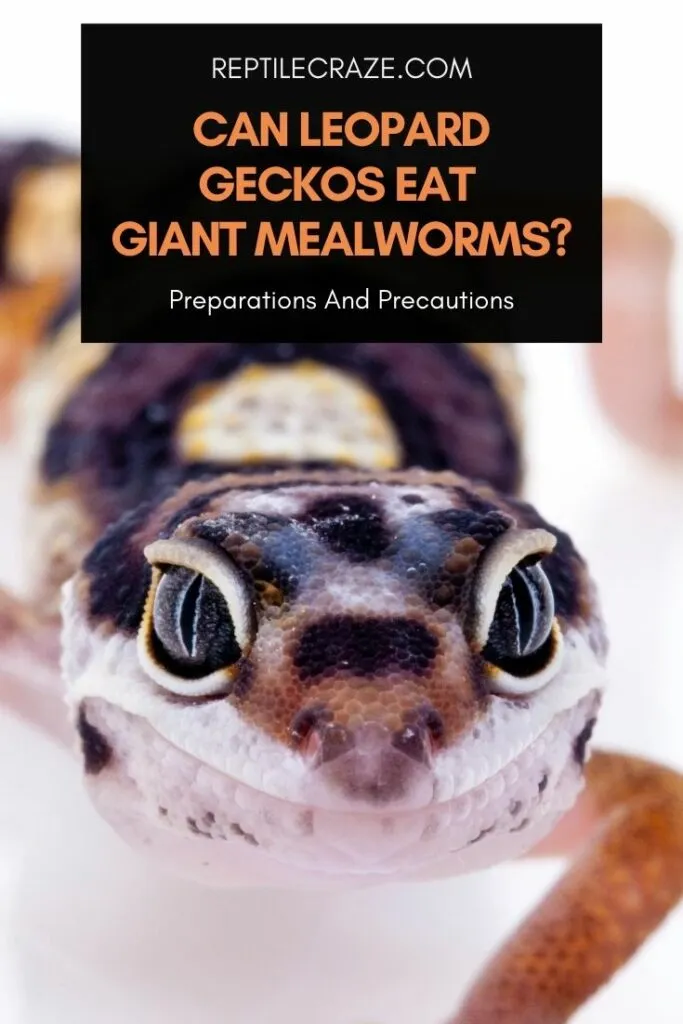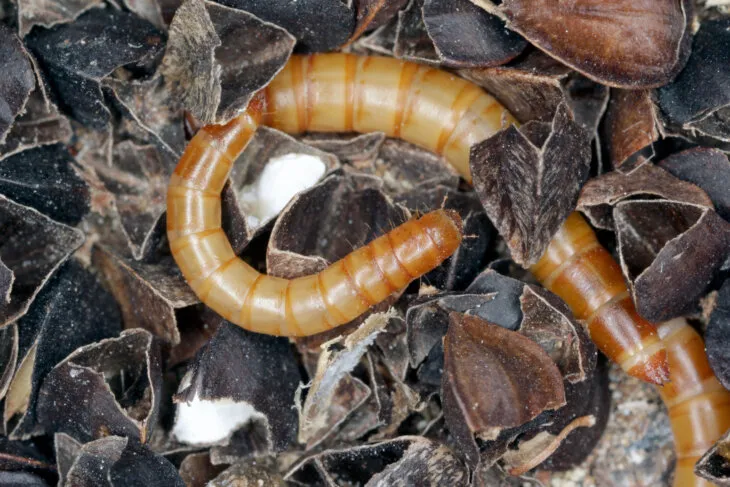
Every leopard gecko loves mealworms – and with giant mealworms, there’s even more to love! But if giant mealworms are new to you, you might be wondering what exactly they are, and how they differ from your leo’s regular insect menu.
Giant mealworms are an exceptionally nutritious
Read on to learn more about these insects, and the best practices to follow when feeding them to your leopard gecko.
Table of Contents
Giant Mealworms: A Safe Diet Choice For Leopard Geckos
Giant mealworms are Tenebrio molitor larvae that have been hormonally treated in the pre-pupal stage.
They differ from regular mealworms in that they never mature into adult T. molitor or yellow mealworm beetles. Instead, they grow to large sizes, reaching up to 3.8 cm and weighing 300 mg.
They have high protein and meat content and can be fed to adult leopard geckos. Studies have shown that leopard geckos fed on a diet of mealworms grow bigger than those fed a mixed diet or on crickets only.
| Mealworm | Giant mealworm | Superworm | |
| Size (cms) | 1 – 1.8 | 2.5 – 3.8 | 3.8 – 6 |
| Protein (mg/g) | 187 | 184 | 197 |
| Fat (mg/g) | 134 | 168 | 177 |
| Moisture (mg/g) | 619 | 610 | 579 |
| Dietary fiber | 27 | 1 | 11 |
| Metabolizable energy (cal/g) | 2056 | 2252 | 2423 |
| Calcium (mg/kg) | 196 | 184 | 177 |
| Phosphorus (mg/kg) | 2720 | 2370 | 2850 |
| Storage | Can be refrigerated | Can be refrigerated | Cannot be refrigerated |
| Safety | Safe for feeding to leopard geckos | Safe for feeding to adult leopard geckos | Can bite and wound leopard geckos |
Giant mealworms differ from other larval diets such as regular mealworms (in size) and from superworms (in nutritive content and size).
Superworms are 5 times larger than giant mealworms. They are rich in calcium, but are higher in fat than giant mealworms and contain slightly lower protein levels. This makes giant mealworms the healthier choice.
Superworms can also harm your gecko by biting or stinging it. Giant mealworms, on the other hand, cause no wounds at all.
In addition, giant mealworms can be refrigerated, whereas other feeder insects cannot. Their easy storage and higher meat content make them a great dietary choice for your pet leopard gecko.
Ideally, leopard geckos should only be fed live
Precautions For Feeding Your Leopard Gecko Giant Mealworms
Though giant mealworms are a safe
- Baby leopard geckos may not be able to ingest giant mealworms, and should instead be fed with regular, smaller mealworms (6-8 mealworms) every day;
- Adolescent or juvenile geckos, likewise, must be fed preferably with other insect diets, such as crickets or yellow mealworms (8-10 mealworms), every other day, to avoid impaction;
- Mature adult geckos can be given giant mealworms (6-9 giant mealworms), 2-3 times a week. Pay attention to the relative size of the insect.
As a rule of thumb, geckos can be fed with
It’s a good idea to include the same quantities of regular

Building Your Leopard Gecko’s Giant Mealworm Diet Routine From Scratch
Now that we know the basics of feeding giant mealworms to your gecko, we can dig deeper into the steps you need to take when incorporating them into its dietary routine.
Where Can You Find Giant Mealworms?
Giant mealworms are available in pet stores, and can also be purchased online. Make sure that your mealworms are alive, and keep them refrigerated when necessary, to both prolong shelf-life and arrest their development at the larval stage.
Some pet stores where you can find well-fed and healthy giant mealworms are Josh’s Frogs live feeder store, Northampton Reptile Center, and Rainbow Mealworms.
Once you have your giant mealworms, you can keep them alive for 30 days without refrigeration, so make sure to order new stock each month.
Preparing Giant Mealworms For Feeding Your Leopard Gecko
Leopard geckos cannot directly feed on vegetables or fruits, since, unlike other geckos, they do not have the capacity to digest plant matter. Therefore, to replenish and increase the gecko’s nutrition intake, giant mealworms can be gut-loaded or dusted.
Gut loading giant mealworms
Gut-loading is when giant mealworms are ‘plumped’ up prior to feeding them to your pet so that they can pass on the vitamins and minerals they fed on to the gecko.
This is done by first cleaning them off the packing material they arrive in and putting them in a container with feed such as a thin slice of carrot.
The fully-fed giant mealworms can then be placed in the same
Dusting giant mealworms
Dusting is done when your gecko isn’t getting enough vitamins or minerals.
A fine supplement powder, such as calcium dust, can be added to your container of giant mealworms, after spraying them with a fine mist of water so that the dust will stick to them.
After dusting, the giant mealworms can be immediately fed to your pet, to avoid the vitamin dust rubbing off.
Leaving Giant Mealworms In Your Gecko’s Tank
If you’re unable to schedule a feeding time for your pet during the workday, you can leave giant mealworms in the same
Make sure to include a few slices of carrots in the
Final Thoughts
Giant mealworms are great insect feeders for your leopard gecko, due to their balanced nutritive value and higher meat content.
They can be stored easily, and fed to your pet with minimal supplementation. Gut-loading and dusting them are simple steps that can be followed prior to feeding them to your leopard gecko to increase their nutritional value.
- Enchi Ball Python: A Unique and Stunning Morph of Python regius - March 27, 2025
- Emerald Tree Monitor: The Enigmatic Green Guardian of the Rainforest - March 26, 2025
- The Egyptian Cobra (Naja haje): A Fascinating Serpent - March 25, 2025
